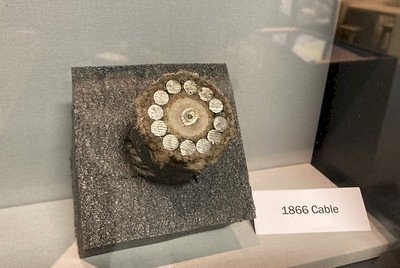Ireland
Transatlantic Cable Ensemble (IE)
The Transatlantic Cable Ensemble comprises both end-points of the first trans-oceanic submarine electric telegraph cable: Valentia Island (Ireland) and Heart’s Content (Canada). The connection became successful in 1866 and improved the speed of communication between the continents significantly. At both sites, the historic cable stations remain.
Site Info
Official Information
- Full Name
- Transatlantic Cable Ensemble (Ireland) (ID: 6634)
- Country
- Ireland
- Status
-
On tentative list 2023
Site history
History of Transatlantic Cable Ensemble (IE)
- Type
- Cultural
- Criteria
Links
- UNESCO
- whc.unesco.org
All Links
UNESCO.org
- whc.unesco.org — whc.unesco.org
Community Information
- Community Category
- Human activity: Transport and Trade
Travel Information
Recent Connections
News
No news.
Community Reviews
Show full reviews
In readiness for its likely addition to Ireland’s T List, we paid a visit to the Transatlantic Cable Station on Valentia Island in June 2022. A simple review of the visit isn’t going to take very long as, in all honesty, there isn’t a great deal to see, and what there is isn’t that exciting! Perhaps of more interest to WHS travelers is its history towards nomination - informed by the visit itself and some pre and post visit investigations up to the site’s addition to the Irish T List in Feb 2023.
At the time we were visiting “blind” regarding what might be proposed. The Canadian element at Heart’s Content Newfoundland hadn’t officially been added to its T List on the UNESCO Web site either, even though the Canadian Government Web site had it listed with a date of 20 Dec 2017 - presumably it/UNESCO were waiting until both ends could be added at the same time. The descriptions there implied that only the 2 cable station “ensembles” (whatever that meant) were to be included using Crits ii and iv. (“The Heart’s Content/Valentia Cable Station ensemble are outstanding monuments representing the remarkable advances in communication technology during the mid to late 19th century” and “The Heart’s Content/Valentia Cable Station ensemble is a well preserved and outstanding example of a telecommunications site”).
This was called into question when we picked up a nice brochure in Valentia for a “Transatlantic Cable Trail”. See this on …
Keep reading 0 comments
The inclusion of the Transatlantic Cable Ensemble: Valentia-Heart’s Content in Ireland’s updated Tentative List brings a bit more spice for WH travellers to this corner of Ireland, County Kerry. It gives you something to do while waiting for a boat to Skellig Michael. I have been there twice, both for that reason. Valentia Island lies a 2.5h drive from Cork Airport on roads where you always have to be on guard – they are busy and narrow, and there always is some goat fair going on at Killarney or Killorglin; I hated the drive both times.
During my first visit in 2019, there still was very little information about which spots on Valentia the TWHS would cover. The cable station was the best bet, but it wasn’t accessible then as it was in private use and I had to make do with a couple of small memorials across the street. One is a slab of stone displaying the text of a telegram sent via the cable during WWI, another is a black-and-white pole (symbolizing a cable?), and the third is a commemorative stone bollard (its partner stands 3,071 km away at the other end of the ocean).
In June 2022, I visited Newfoundland as part of my East Canada road trip. It would have been an excellent chance to see the other end of the cable: Heart’s Content, a possible 11th WHS in the East Canada “cluster”, and the 4th WHS in Newfoundland. But it takes quite a detour from …
Keep reading 0 comments